NCERT Exemplar Class 11 Physics Chapter 9 Mechanical Properties of Fluids are part of NCERT Exemplar Class 11 Physics . Here we have given NCERT Exemplar Class 11 Physics Chapter 9 Mechanical Properties of Fluids.
NCERT Exemplar Class 11 Physics Chapter 9 Mechanical Properties of Fluids
Q1. A tall cylinder is filled with viscous oil. A round pebble is dropped from the top with zero initial velocity. From the plot shown in figure, indicate the one that represents the velocity (v) of the pebble as a function of time (t).
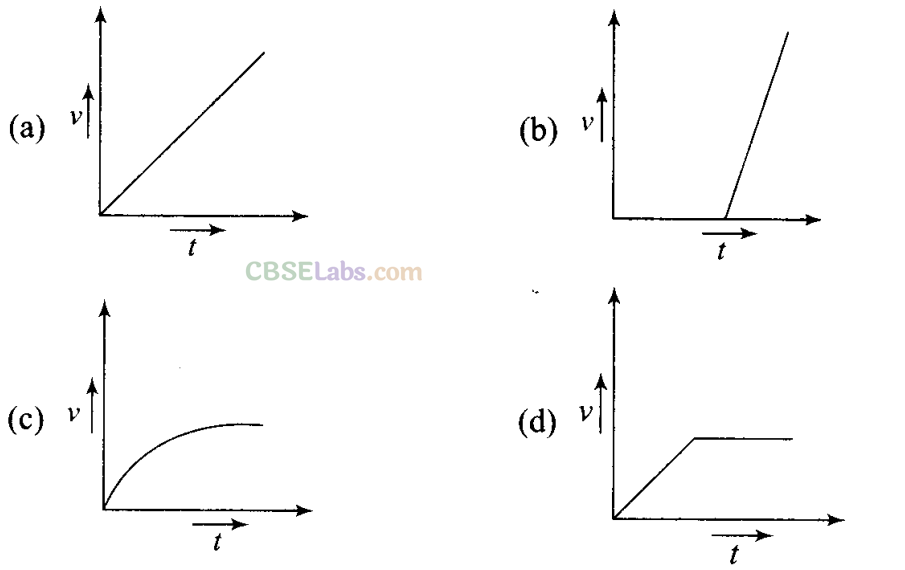
Sol:
(c) In fluids, when the pebble is dropped from the top of a tall cylinder filled with viscous oil, a variable force called viscous force will act which increases with increase in speed. And at equilibrium this velocity becomes constant, that constant velocity is called terminal velocity.
When the pebble is falling through the viscous oil, the viscous force is F= 6πηrv
where r is the radius of the pebble, v is instantaneous speed, η is coefficient of viscosity. As the force is variable, hence acceleration is also variable so v-t
graph will not be a straight line. First velocity increases and then becomes constant known as terminal velocity.
Q2. Which of the following diagrams does not represent a streamline flow?
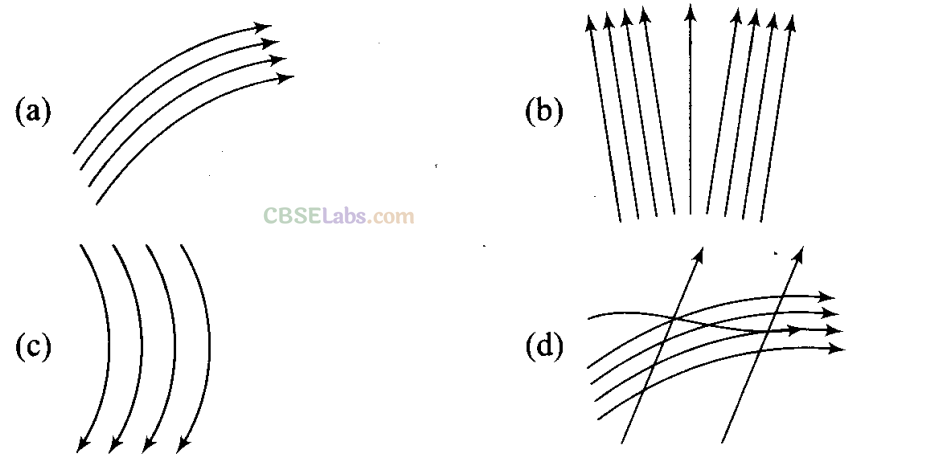
Sol. (d)
Streamline flow: Streamline flow of a liquid is that flow in which each element of the liquid passing through a point travels along the same path and with the same velocity as the preceding element passes through that point.
A streamline may be defined as the path, straight or curved, the tangent to which at any point gives the direction of the flow of liquid at that point.
The two streamlines cannot cross each other and the greater is the crowding of streamlines at a place, the greater is the velocity of liquid particles at that place. If we consider a cross¬sectional area, then a point on the area cannot have different velocities at the same time
Path ABC is streamline as shown in the figure and v1, v2 and v3 are the velocities of the liquid particles at A, B and C point respectively.
Q3. Along a streamline,
(a) the velocity of a fluid particle remains constant
(b) the velocity of all fluid particles crossing a given position is constant
(c) the velocity of all fluid particles at a given instant is constant
(d) ‘ the speed of a fluid particle remains constant,
Sol:(b) As discussed above for a streamline flow of a liquid velocity of each particle at a particular cross-section is constant, because Av = constant (law of continuity) between two cross-section of a tube of flow. So we can say that along a streamline, the velocity of every fluid particle while crossing a given position is the same.
Q4. An ideal fluid flows through a pipe of circular cross-section made of two sections with diameters 2.5 cm and 3.75 cm. The ratio of the velocities in the two pipes is
(a) 9:4 (b) 3:2 (c)√3: √2 (d)√2:√3
Sol: (a) The situation is shown in the diagram below in which an ideal fluid is flowing through a pipe of circular cross sections.
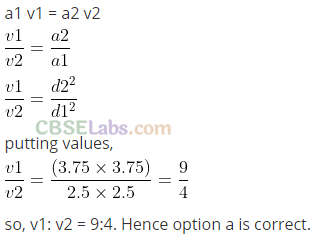
Q5. The angle of contact at the interface of water-glass is 0°,
ethylalcohol
-glass is 0°, mercury-glass is 140° and
methyliodide
-glass is 30°. A glass capillary is put in a trough containing one of these four liquids. It is observed that the meniscus is convex. The liquid in the trough is
(a) water
(b) ethylalcohol
(c) mercury
(d) methyliodide
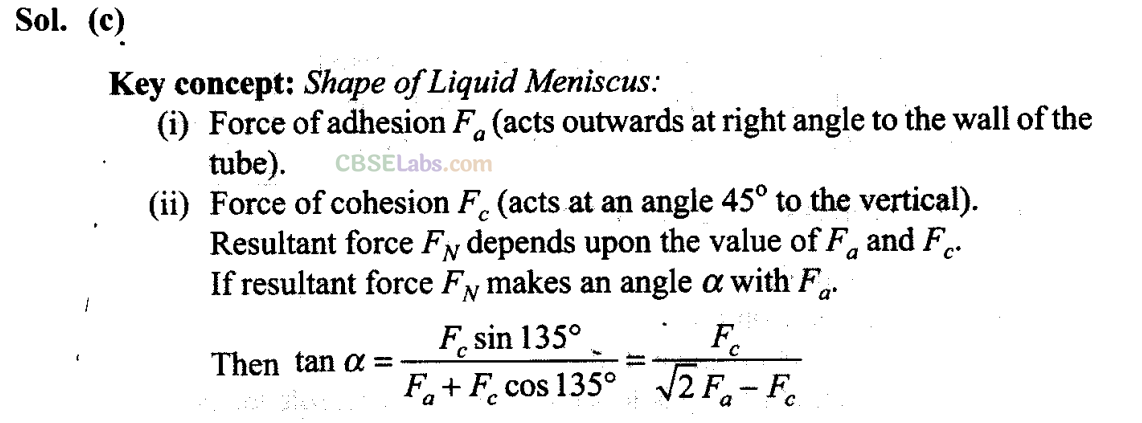
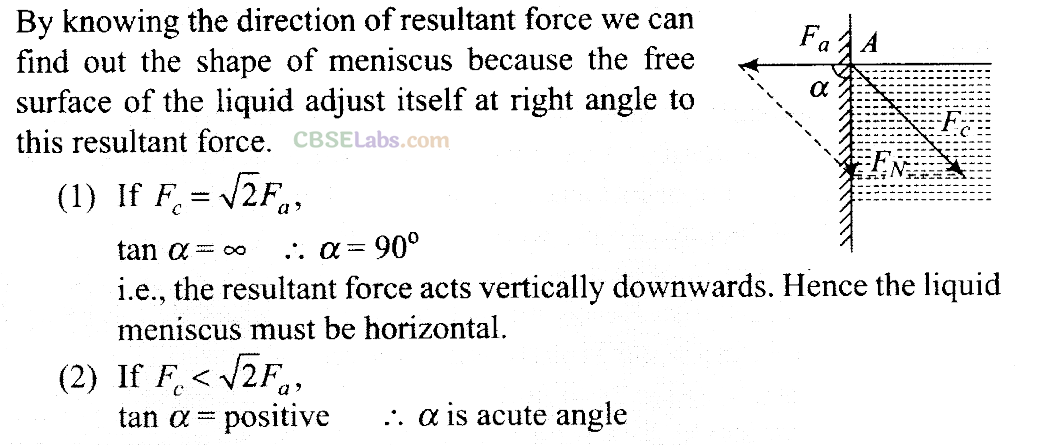
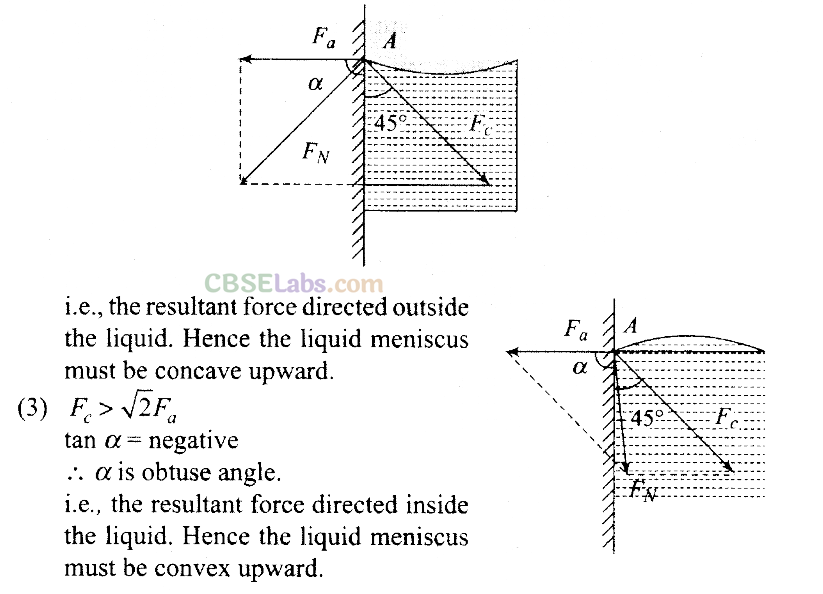
According to the question, the observed meniscus of liquid in a capillary tube is of convex upward which is only possible when angle of contact is obtuse. It is so when one end of glass capillary tube is immersed in a trough of mercury. Hence, the combination will be of mercury-glass (140°) as shown in the figure.
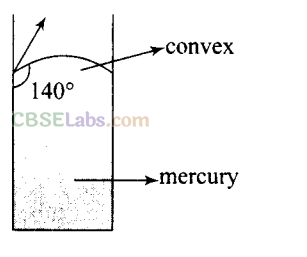
More Than One Correct Answer Type
Q6. For a surface molecule,
(a) the net force on it is zero
(b) there is a net downward force
(c) the potential energy is less than that of a molecule inside
(d) the potential energy is more than that of a molecule inside
Sol:
(b, d)
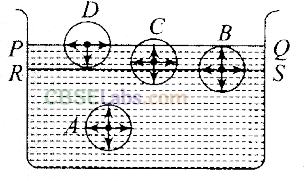
Key concept: To understand the concept of tension acting on the free
surface of a liquid, let us consider four liquid molecules like A, B, C and D. Their sphere of influence are shown in the figure.
(1) Molecule A is well within the liquid, so it is attracted equally in all directions. Hence the net force on this molecule is zero and it moves freely inside the liquid.
(2) Molecule B is little below the free surface of the liquid and it is atso attracted equally in all directions. Hence the resultant force acts on it is also zero
(3) Molecule C is just below the upper surface of the liquid film and the part of its sphere of influence is outside the free liquid surface. So the number of molecules in the upper half (attracting the molecules upward) is less than the number of molecule in the lower half (attracting the molecule downward). Thus the molecule C experiences a net downward force.
(4) Molecule D is just on the free surface of the liquid. The upper half of the sphere of influence has no liquid molecule. Hence the molecule D experiences a maximum downward force.
Thus all molecules lying on surface film experiences a net downward force. Therefore, free surface of the liquid behaves like a stretched membrane.
From the key concept, it is clear from point (4) that molecules on the surface experiences a net downward force. As shown in figure above, molecule D experiences a net downward force. Because on the above side of this molecule there is no liquid molecule. So, the potential energy is more than that of a molecule inside. Hence option (b) and (d) are correct.
Q7. Pressure is a scalar quantity, because
(a) it is the ratio of force to
area
and both force and area are vectors.
(b) it is the ratio of the magnitude of the force to area.
(c) it is the ratio of the component of the force normal to the area.
(d) ‘it does not depend on the size of the area chosen.
Sol:
(b, c) Pressure is defined as the ratio of magnitude of component of the force normal to the area and the area under consideration.
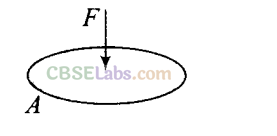
i.e P = F/A
Pressure is a scalar quantity. Pressure acts normal to a surface and it is always compressive in nature, therefore, only its magnitude is required for its complete description.
Q8. A wooden block with a coin placed on its top, floats in water as shown in figure.
The distance / and h are shown in the figure. After sometime, the coin falls into the water. Then,
(a) l decreases
(b) h decreases
(c) l increases
(d) h increases
Sol: (a, b)
Key concept: When a body of density ρ and volume V is immersed in a liquid of density σ, the forces acting on the body are:
1. Weight of body W = mg = Vpg, acting vertically downwards through centre of gravity of the body
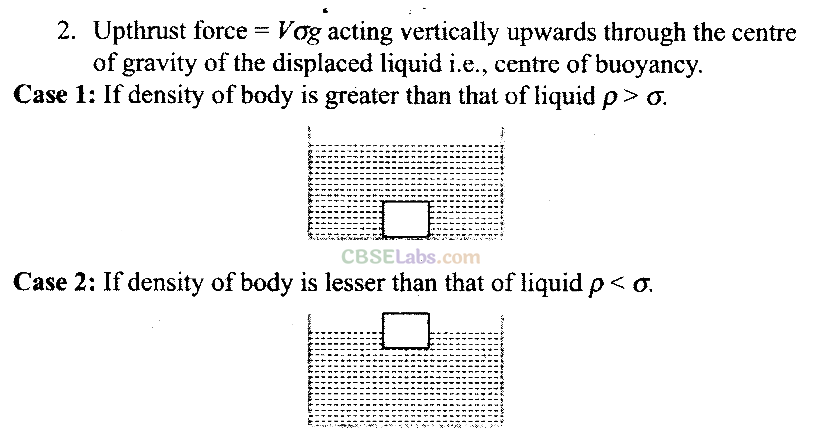
When coin is in water, volume of water displaced by coin is equal to the volume of coin V
1
(say).
When the coin falls into the water, weight of the (block + coin) system decreases, which was balanced by the upthrust force earlier. As weight of the system decreases, block moves up. Hence ldecreases.
When coin is at the top of wooden block, it displaces a volume of water V
2
, which is more than V
1
Because,
Weight of coin = Weight of volume of water displaced by coin (when coin is at .the top of wooden block)
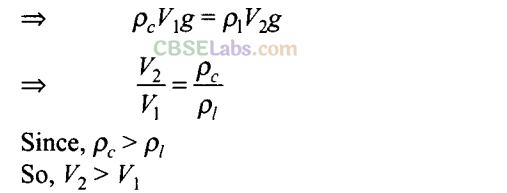
Hence, upthrust force will also decrease. As volume of water displaced by the block decreases, hence h decreases.
Q9. With increase in temperature, the viscosity of
(a) gases decreases
(b) liquids increases
(c) gases increases
(d) liquids decreases
Sol:
(c, d) The viscosity of gases increases with increase of temperature, because on increasing temperature the rate of diffusion increases.
The viscosity of liquid decreases with increase of temperature, because the cohesive force between the liquid molecules decreases with increase of temperature.
Relation between coefficient of viscosity and temperature (Andrade formula)

where T = Absolute temperature of liquid, p = density of liquid, A and C are constants.
Important point: With increase in temperature, the coefficient of viscosity of liquids decreases but that of gases increases. The reason is that as temperature rises, the atoms of the liquid become more mobile, whereas in case of a gas, the collision frequency of atoms increases as their motion becomes more random.
Q10. Streamline flow is more likely for liquids with
(a) high density (b) high viscosity
(c) low density (d) low viscosity
Sol:
(b, c) Streamline flow is more likely for liquids having low density. We know that greater the coefficient of viscosity of a liquid more will be the velocity gradient, hence each line of flow can be easily differentiated. Streamline flow is related with critical velocity. The critical velocity is that velocity of liquid flow up to which its flow is streamlined and above which its flow becomes turbulent.
As the critical velocity is related to viscosity ( η) and density (ρ) of the liquid as:
(V c ) α η/ρ
Hence if the density will be low and viscosity will be high, the value of critical velocity will be more. So, option (b) and (c) are correct.
Very Short Answer Type Questions
Q11. Is viscosity a vector?
Sol: Viscosity is not a vector quantity. It is a scalar quantity because viscosity is a property of liquid as it does not have any direction.
Q12. Is surface tension a vector?
Sol:
Surface tension of a liquid is measured by the force acting per unit length on either side of an imaginary line drawn on the free surface of liquid, the direction of this force being perpendicular to the line and tangential to the free surface of liquid. So if F is the force acting on one side of imaginary line of length L, then T= (F/L)
It depends only on the nature of liquid and is independent of the area of surface or length of line considered.
It is a scalar quantity as it has a unique direction which is not to be specified

![]()
Q14. A vessel filled with water is kept on a weighing pan and the scale adjusted to zero. A block of mass Mand density p is suspended by a massless spring of spring constants k. This block is submerged inside into the water in the vessel. What is the reading of the scale?
Sol:
As shown in the diagram, A block of mass M and density p is suspended by a massless spring of spring constants k. This block is submerged into the water in the vessel.
The scale is adjusted to zero, therefore, when the block suspended to a spring is immersed in water, then the reading of the scale will be equal to the upthrust on the block due to water.
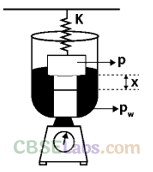
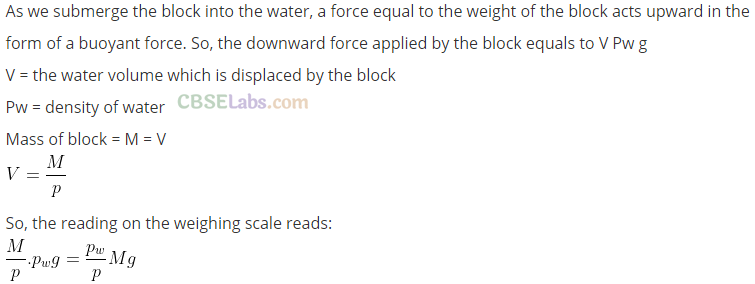
Important point:
If the scale is not adjusted to zero as said earlier, reading on the scale will be different. Then weight of vessel and weight of water is also added in the reading.
Q15. A cubical block of density ρ is floating on the surface of water. Out of its height L, fraction x is submerged in water. The vessel is in an elevator accelerating upward with acceleration a. What is the fraction immersed?
Sol:
Key concept: When a fluid is subjected to constant vertical acceleration, its free surface remains horizontal as the net effective gravity is acting vertically. But the magnitude of pressure at a point in the fluid increases or decreases depending upon the direction of acceleration.
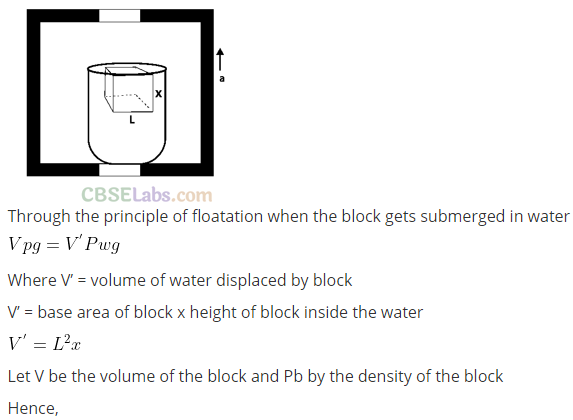
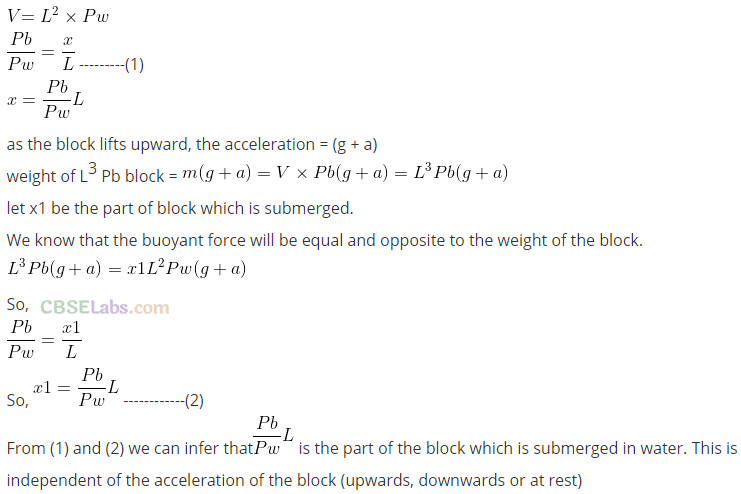
Short Answer Type Questions
Q16. The sap in trees, which consists mainly of water in summer, rises in a system of capillaries of radius r = 2.5 x 10
-5
m. The surface-tension of sap is T = 7.28 x 10
-2
Nm
-1
and the angle of contact is 0°. Does surface tension alone account for the supply of water to the top of all trees?
Sol:
According to the problem, radius (r) = 2.5 x 10
-5
m Surface tension (S) = 7.28 x 10
-2
N/m
Angle of contact (θ) = 0°
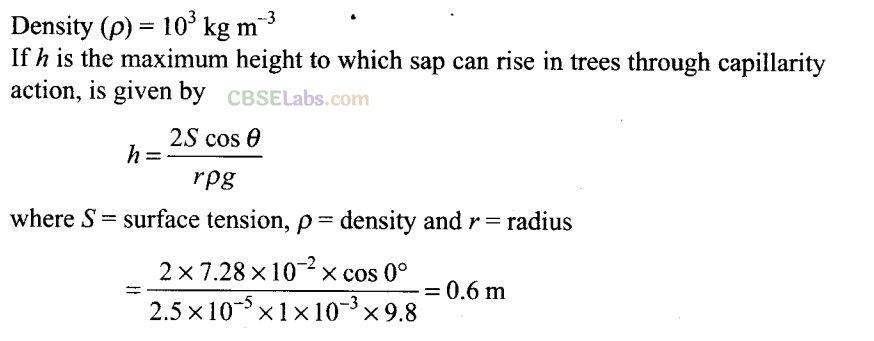
This is the maximum height to which the sap can rise due to surface tension. Many trees have heights much greater than 0.6 m, so only this action is not sufficient for supply of water to the top of such long tree.
Q17. The free surface of oil in a tanker, at rest, is horizontal. If the tanker starts accelerating the free surface will be
titled
by an angle θ. If the acceleration is a ms
-2
, what will be the slope of the free surface?
Sol:
Key concept: The behaviour of a liquid contained in a horizontally accelerated vessel can be understood by understanding the behaviour of a pendulum suspended from the ceiling of a horizontally accelerated trolley.
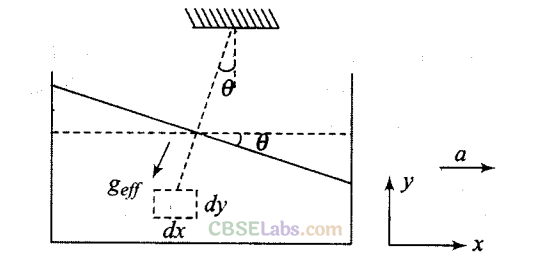
Every fluid element attains an equilibrium position under the action of gravity and pseudo force. The free surface of the liquid orients itself perpendicular to the direction of net effective gravity.
tan
θ = a/g
Suppose tanker accelerates along x-axis with acceleration a, free surface of the tanker will not be horizontal because pseudo force acts as shown in the diagram.
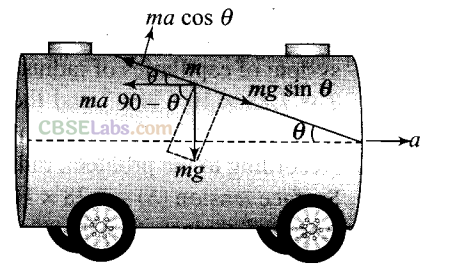
Consider an elementary particle of the oil of mass m.
The acting forces on the particle with respect to the tanker are shown in the figure alongside.
Now, balancing forces (as the particle is in equilibrium) along the inclined direction of surface.
ma
= pseudo force
mg
= weight of small part of oil.
Along free surface,
Net force = 0
=> ma cos θ = mg sin θ
=> a = g tan θ
=> θ = tan
-1
(a/g)
Q18.Two mercury droplets of radii 0.1 cm and 0.2 cm collapse into one single drop. What amount of energy is released? The surface tension of mercury T=5 x 10
-3
Nm
_1
Sol:
When two drops form a bigger drop, volume remains conserved.
According to the problem, there is two mercury droplets of different radii collapse into one single drop.
Radius of smaller drop = r, = 0.1 cm = 10
-3
m,
Radius of bigger drop = r
2
= 0.2 cm = 2 x 10
-3
m
Surface tension (7) = 435.5 x 10
-3
N/m
Let V
1
and V
2
be the volumes of these two mercury droplets and volume of big drop formed by collapsing is V.
Volume of big drop = Volume of small droplets
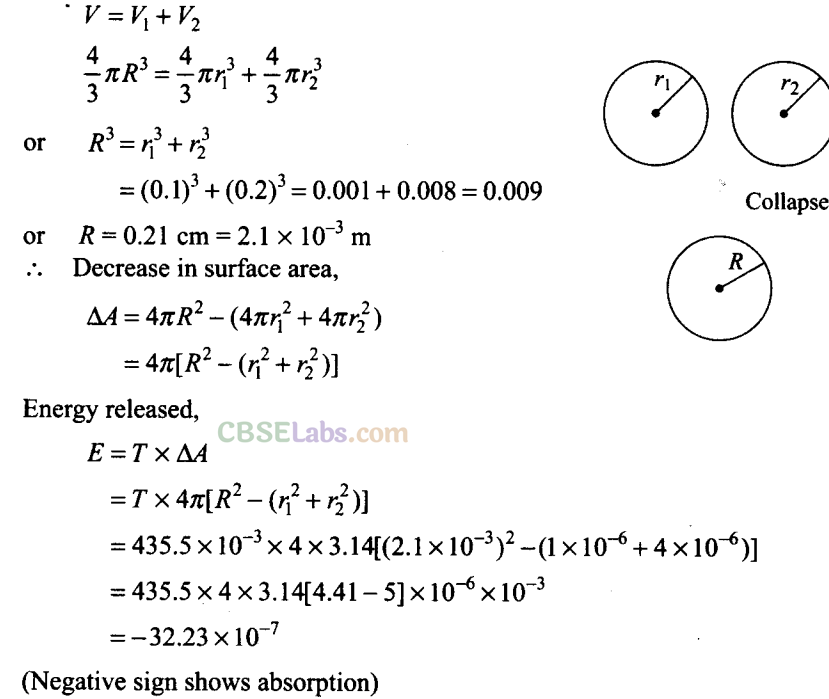
Therefore, 3.22 x K -6 J energy will be absorbed. So, the surface area of the water decreases means surface area of bigger drop is less than the sum of surface area of two smaller drops.
Q19. If a drop of liquid breaks into smaller droplets, it results in lowering of
temperature
of the droplets. Let a drop of radius R, breaks into N small droplets each of radius r. Estimate the drop in temperature.
Sol:
The volume remains conserved, when a big drop, breaks into N small droplets.
Volume of liquid drop of radius R
=
(Volume of liquid droplet of radius
r)xN
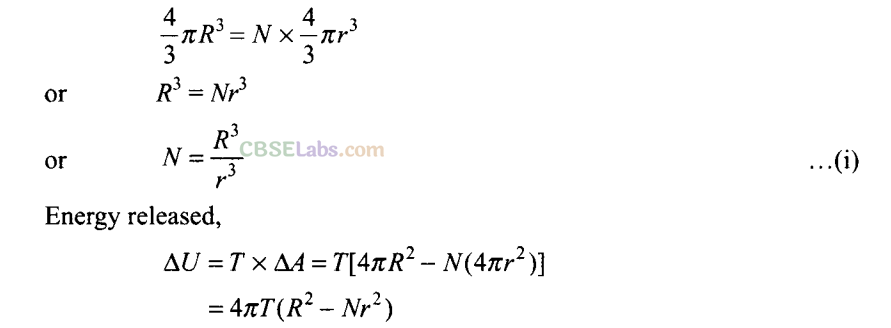
Due to releasing of this energy, the temperature is lowered.
If c is specific heat of liquid and its temperature is lowered by ΔT, then Energy released, ΔU – me ΔT
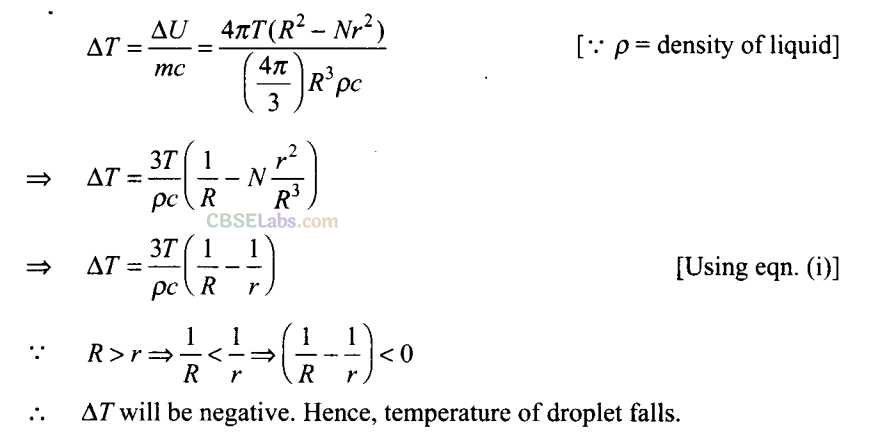
Q20. The surface tension and vapour pressure of water at 20°C is 7.28 x 10
-2
Nm
-1
and 2.33 x 10
3
Pa, respectively. What is the radius of the smallest spherical water droplet which can form without evaporating at 20°C?
Sol:
According to the problem, surface tension of water, T = 7.28 x 10
-2
N m
-1
Vapour pressure P = 2.33 x 10
3
Pa Let r = radius of drop, which formed without evaporating.
The excess pressure (2T/r) should be greater than the vapour pressure. Then, the drop will evaporate.
Vapour pressure = Excess pressure in drop

Long Answer Type Questions
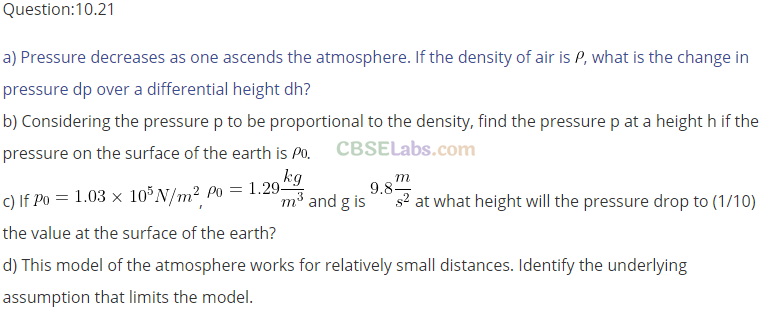
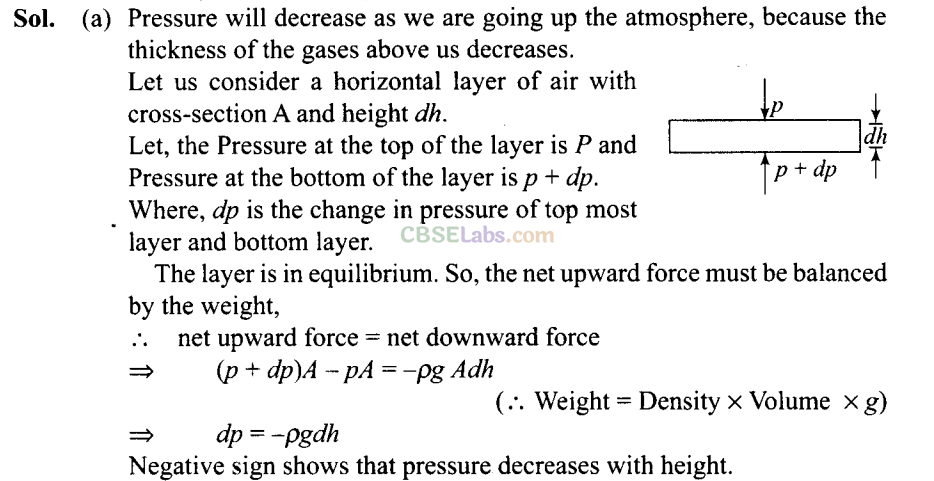
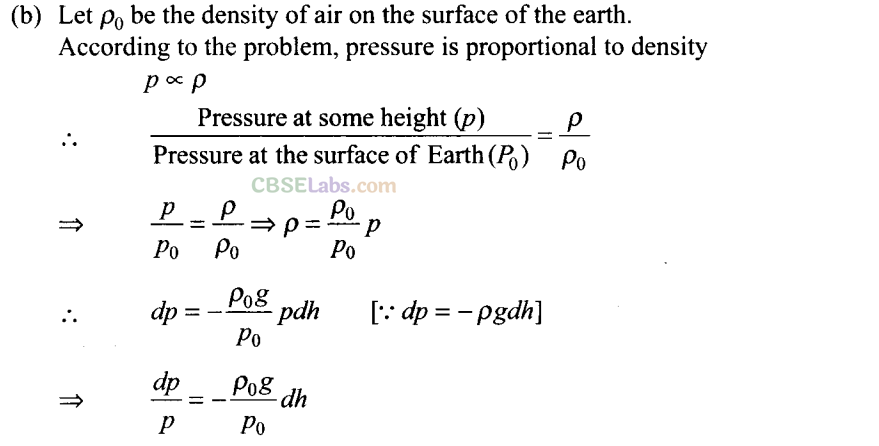
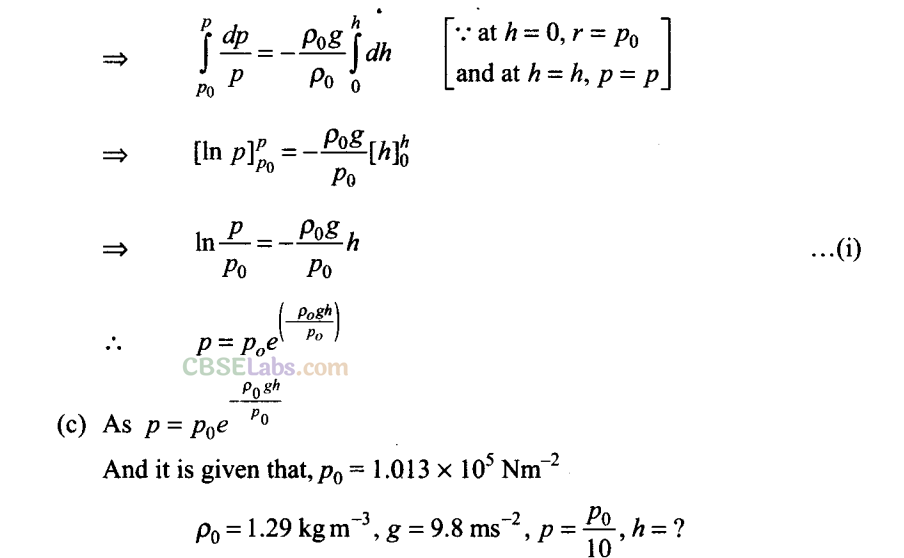

Q22. Surface tension is exhibited by liquids due to
force
of attraction between molecules of the liquid. The surface tension decreases with increase in temperature and vanishes at boiling point. Given that the latent heat of vaporisation for water L
v
= 540 kcal kg
-1
, the mechanical equivalent of heat J = 4.2 Jeal
-1
, density of water
p
w
= 10
3
kg
-1
, Avogadro’s number
N
a
= 6.0 xlO
26
kmole
‘
1
and the molecular weight of water M
A
= 10 kg for 1
kmole
.
(a) Estimate the energy required for one molecule of water to evaporate

(c) 1 g of water in the vapour state at 1 atm occupies 1601 cm
3
. Estimate the inter-molecular distance at boiling point, in the vapour state.
(d) During vaporisation a molecule overcomes a force F, assumed constant, to go from an inter-molecular distance d to Estimate the value of F.
(e) Calculate Fid, which is a measure of the surface tension.
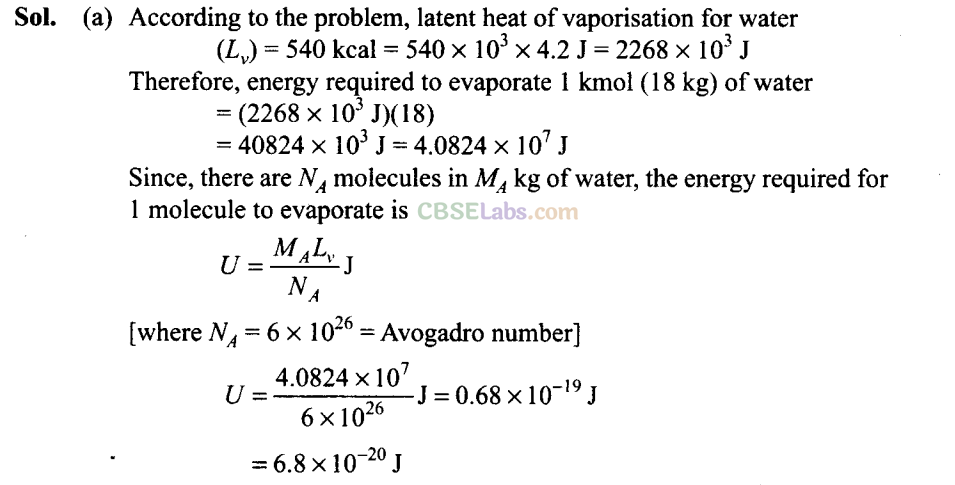
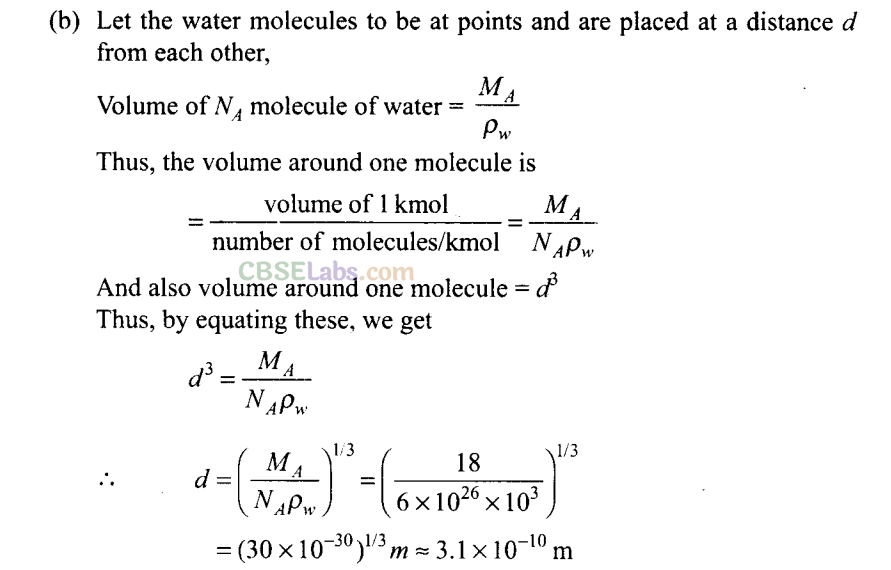

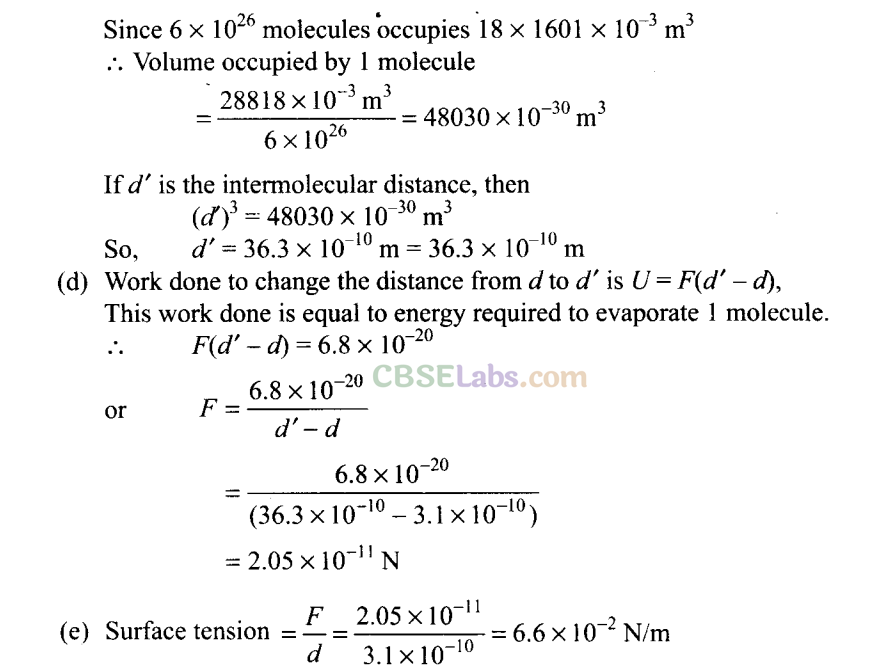
Q23. A hot air balloon is a sphere of radius 8 m. The air inside is at a temperature of 60°C. How large a mass can the balloon lift when the outside temperature is20°C? Assume air in an ideal gas, R = 8.314 J mole -1 K ‘, 1 atm = 1.013 x 10 s Pa, the membrane tension is 5 Nm -1 .
Sol: Pressure inside the curved surface Will be greater than of outside pressure
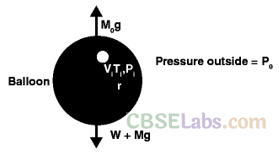
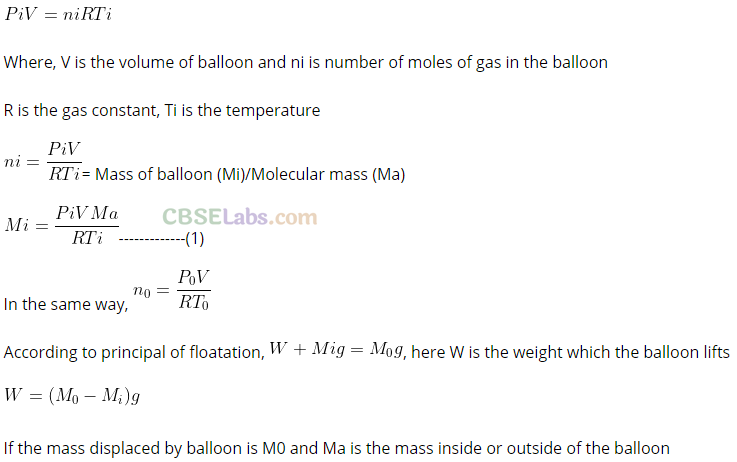
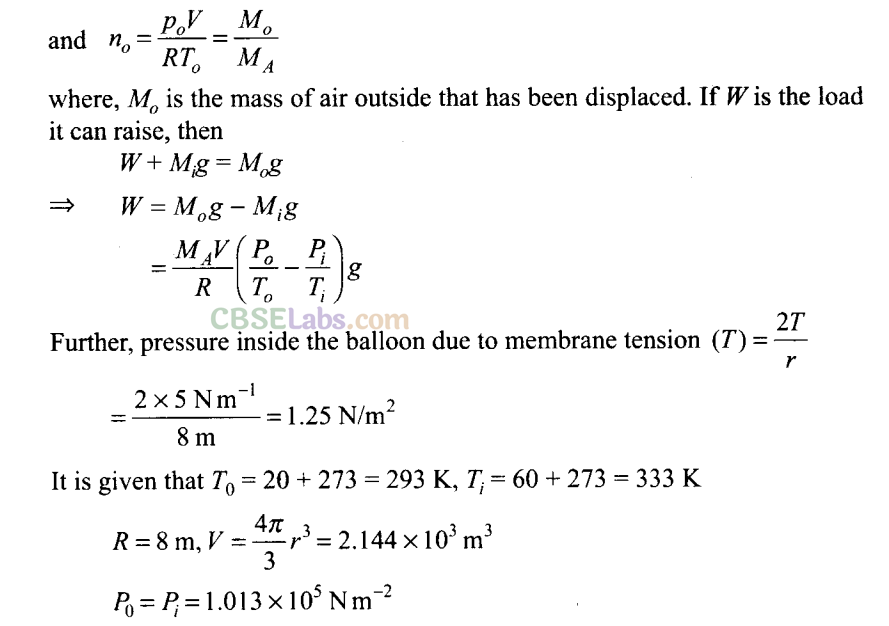

NCERT Exemplar Class 11 Physics Solutions
- Chapter 1 Units and Measurements
- Chapter 2 Motion in a Straight Line
- Chapter 3 Motion in a Plane
- Chapter 4 Laws of Motion
- Chapter 5 Work, Energy and Power
- Chapter 6 System of Particles and Rotational Motion
- Chapter 7 Gravitation
- Chapter 8 Mechanical Properties of Solids
- Chapter 9 Mechanical Properties of Fluids
- Chapter 10 Thermal Properties of Matter
- Chapter 11 Thermodynamics
- Chapter 12 Kinetic Theory
- Chapter 13 Oscillations
- Chapter 14 Waves